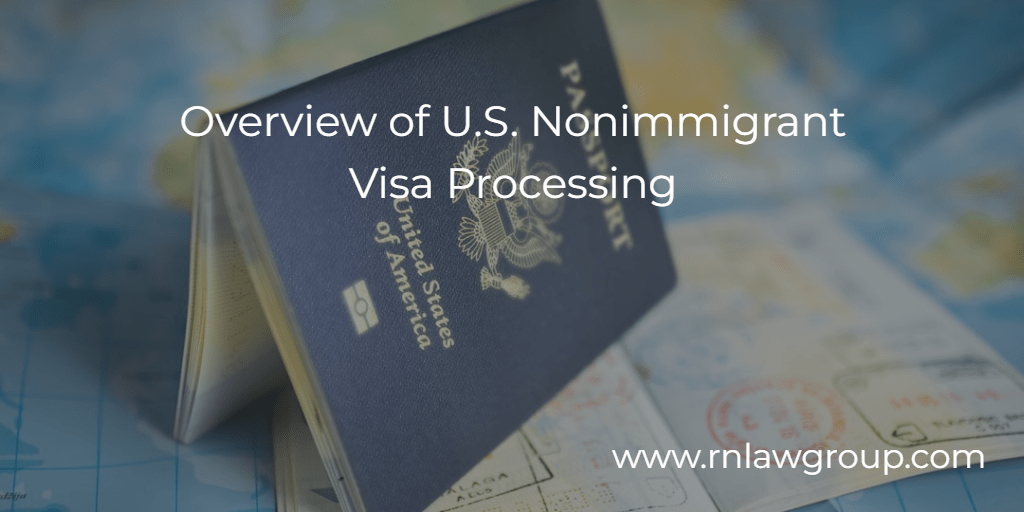
Overview of U.S. Nonimmigrant Visa Processing
What Is a Nonimmigrant Visa?
A nonimmigrant visa is placed in your passport and grants you permission to travel to the United States on a temporary basis. Generally, a citizen of a foreign country who wishes to travel to the United States must apply for and obtain a U.S. visa that fits the purpose of their travel. For example, a foreign national who wants to vacation at Disney World will require a B-1/B-2 visitor visa to travel to the United States.
Many foreign nationals already residing in the United States may also need a visa to return to the United States after international travel. For example, an F-1 student who recently changed their status to that of an H-1B worker while in the United States is able to work and remain in the country during the validity printed on their approval notice, but if the H-1B worker now wishes to return to their home country to visit family, they will need to apply for an H-1B visa to return to the United States to resume working in H-1B status.
There are exceptions to visa requirements for Canadians and other foreign nationals who are eligible for visa waiver programs. You should speak to your immigration attorney if you have questions about whether you need a visa to travel.
What are the Steps to Apply for a Visa?
There are two steps to the visa process:
STEP 1 – Completing a DS-160 online visa application.
The DS-160 is an online form used to apply for temporary U.S. visas, including B-1/B-2, H-1B, and K (fiancé(e)) visas, to name a few. Each nonimmigrant visa applicant, including their spouse and children, must complete a separate DS- 160 Online Nonimmigrant Visa Application. Applicants can access the DS-160 through this website: https://ceac.state. gov/genniv/
Some important reminders:
- You should be prepared to provide personal and biographic information (e.g., passport, address, travel, work, and education information), and you may also be required to upload a passport-sized photo as part of this process.
- You can access the application questions in different languages by selecting a language on the top right-hand side of the website where it says, “select tooltip ” If you select a language other than English, when you click on any sentence, it will automatically be translated for you. Note that the application must be completed in English.
- When you start Form DS-160, the website will provide you with an application ID. You should print or save this so you can access it easily.
- The government’s website can be difficult to navigate and is frequently out of service, so you will want to click the “save” button very often, so your answers are not lost if you get logged out.
- The DS-160 application is automatically deleted if it is not accessed for 30 days, so you will want to schedule a calendar reminder to access your DS-160 application every few weeks if you cannot complete it right away.
- Once you have completed the Form DS-160, you should save your DS-160 Confirmation, as you will need it for your visa interview appointment.
STEP 2 – Scheduling and attending your visa appointment.
After you have submitted your DS-160 application, you will need to schedule a nonimmigrant visa appointment with a U.S. embassy or consulate. There are three different systems to book nonimmigrant visa appointments:
The country where you are applying for a visa will determine which system you use to schedule your appointment. Many consular posts in Central America, South America, and Africa use the https://ais.usvisa-info.com website, while posts in India, Australia, Japan, and South Korea use the https://www. usvisascheduling.com website. To determine which system to use to schedule your appointment, you should visit the website of the U.S. embassy or consulate, which usually links to the appropriate scheduling system.
To schedule your appointment through one of these websites, you will need to create an account, log in, select the appropriate visa category, and then pay the nonimmigrant visa application fee. The visa fees vary depending on the visa category for which you are applying. After you have paid the fee, you should be able to select a visa appointment date and time. Each consular office will have different visa appointment wait times, which can vary from a few days to more than a year. If your travel is urgent and there are no appointments available online, you may be able to request an expedited appointment. While many consulate offices require visa applicants to attend an in-person interview, there are some posts where applicants can skip the interview altogether.
The last step in most visa journeys is attending the visa interview. Be sure to carefully review the instructions and required document list provided by the consular office for your interview. The embassy or consulate website usually has a list to help prepare the applicants. Once you are issued your visa, you are permitted to travel to the United States and be admitted in the status listed on the visa.
This flyer is intended for general information purposes only and does not constitute legal advice. You should not act or rely on any information in this flyer without seeking the advice of a competent, licensed immigration attorney.
Reddy Neumann Brown PC, with over two decades of experience, focuses exclusively on U.S. employment-based immigration law and provides comprehensive assistance to both employers and employees in maneuvering through the immigration process efficiently and effectively.
By: Emily Neumann
Emily Neumann is Managing Partner at Reddy Neumann Brown PC with over 15 years of experience practicing US immigration law providing services to U.S. businesses and multinational corporations. Emily has helped transform the firm from a solo practice to Houston’s largest immigration law firm focused exclusively on U.S. employment-based immigration. She received her Bachelor’s degree in Biology from Central Michigan University and her Juris Doctorate degree from the University of Houston Law Center. Emily is a frequent speaker and has been quoted in Bloomberg Law, U.S. News & World Report, Inside Higher Ed, and The Times of India on various hot topics in immigration. She is a member of the American Immigration Lawyers Association and Society for Human Resource Management.

